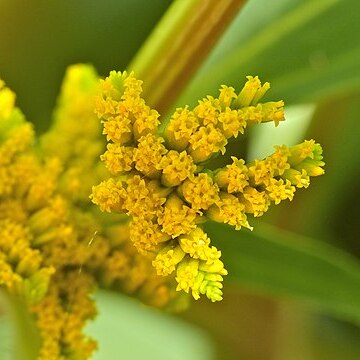Annuals, to 100 cm (delicate or robust, sparsely villous). Stems erect. Leaves petiolate (proximal, petioles 3–15 mm) or sessile (distal); blades lanceolate-elliptic, 50–120(–180) × 10–25(–70) mm, bases (distal) connate, margins serrate or spinulose serrate. Heads 20–100+ in tight subglomerules in scorpioid, cymiform arrays. Calyculi of 1–2 linear bractlets 1–2 mm. Involucres oblong-angular, 5 mm. Phyllaries 3(–4), oblong. Ray florets 0 or 1; laminae pale yellow, ovate-oblique, to 1 mm (not or barely surpassing phyllaries). Disc florets (2–)3–8; corolla tubes ca. 0.8 mm, throats funnelform, 0.8 mm. Cypselae oblanceolate or subclavate, 2–2.5 mm (those of ray florets longer); pappi 0. 2n = 36.
Annuals. Stems erect, to 100 cm tall, sparsely villous. Leaves petiolate (proximal, petioles 3-15 mm) or sessile (distal); blades lanceolate-elliptic, 50-120(-180) × 10-25(-70) mm, bases (distal) connate, margins serrate or spinulose serrate. Capitula 20-100+ in tight subglomerules in scorpioid cymes; calycular bracts 1 or 2, 1-2 mm; involucres oblong-angular, ca. 5 mm; phyllaries 3(or 4), oblong. Ray florets 0 or 1; lamina pale yellow, obliquely ovate, to 1 mm (not or barely surpassing phyllaries). Disk florets (2 or)3-8; corolla tubes ca. 0.8 mm, throats funnelform, ca. 0.8 mm. Achenes oblanceolate or subclavate, 2-2.5 mm (those of ray florets longer); pappus absent. Fl. Jul-Nov. 2n = 36.
Annual herb, up to 1 m high. Leaves opposite; blade narrowly ovate to elliptic, up to 80 x 20 mm, apex acute, margins subentire or callose-serrulate, base cuneate, tapering petiolelike. Heads discoid, few-flowered, many tightly clustered in shortly pedunculate, terminal and axillary, secondary heads. Involucral bracts 3, uniseriate, elliptic, concave, imbricate, forming a cylinder, yellow. Receptacle epaleate. Flowers: disc florets only, yellow; Jan.-May. Fruit with cypsela elliptic or narrowly obovate, ribbed, glabrous. Pappus absent.
Annual herb, up to 1 m high. Leaves opposite, lanceolate to elliptic, margins subentire or callose-serrulate. Heads discoid, few-flowered, many tightly clustered in shortly pedunculate terminal and axillary secondary heads. Pappus absent. Flowers yellow.

